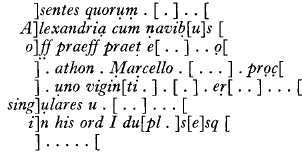Article contents
M. Aurelius Atho Marcellus
Published online by Cambridge University Press: 24 September 2012
Extract
One of the smallest of the papyri in the files of cohors XX Palmyrenorum stationed at Dura-Europos in Syria Coele appears to be one of the most interesting. It is P. Dura 81, which is dated, on similarity of style to another document, to c. A.D. 251:

On the fourth line J. F. Gilliam the editor comments: ‘Following -athon it appears that o was first written and then corrected to i. Possibly these letters are part of a name, perhaps the nomen of Marcellus. Mathoni would be possible, though surprising.’
However, the reading is almost certainly correct as it stands. A Marcus Aurelius Atho Marcellus is attested by two inscriptions as being procurator Mauretaniae Caesariensis at some time between A.D. 246 and 249. I suggest that he is the same person as the man mentioned at Dura for four reasons: Atho is the only example of this nomen to be found in PIR2; the combination with Marcellus; they are both procurators of high rank; they are contemporary.
- Type
- Research Article
- Information
- Copyright
- Copyright ©R. W. Davies 1967. Exclusive Licence to Publish: The Society for the Promotion of Roman Studies
References
1 C. B. Welles, R. O. Fink and J. F. Gilliam, The Excavations at Dura-Europos, Final Report V, Part I: the Parchments and Papyri.
2 Pflaum, H.-G., Les Carrières procuratoriennes équestres sous le haut-empire romain, 1097Google Scholar; Groag, E. and Stein, A., Prosopographia Imperii Romani (second edition), A 1460Google Scholar; Thomasson, B. E., Die Statthalter der römischen Provinzen Nordafrikas von Augustus bis Diokletian 278–279Google Scholar; citing AÉ 1908, 30 and CIL VIII, 8809 = ILS 5785.
3 Pflaum, op. cit. 628.
4 CIL 892–894, no. 342; CIL II, 4135 = ILS 1365.
5 AÉ 1947, 182.
6 Cod. Iust. IX, 51, 1.
7 Howe, L. L., The Pretorian Prefect from Commodus to Diocletian 19, n. 26Google Scholar; 120–123.
8 For discussion and collection of the ancient sources see Cambridge Ancient History XII, 87Google Scholar; H. M. D. Parker, A History of the Roman World from A.D. 138 to 337, 150.
9 CLA 219 = P. Lond. 2851: cf. especially CLA 219, 11, 25 (singulares), 26 (officii Latiniani proc), 33 (ad naves frumentarias).
10 sing]ulares is given in the index but not in the footnotes. This seems more probable than supposing that men from Dura were with the equites singulares Augusti.
11 Howe, op. cit. 78–79, no. 45.
12 ibid. 79, no. 46; 106–111.
13 ibid. 79–80, no. 47; 106–111.
14 ibid. 78–80; RE XXII, 2425.
15 cf. P. Dura 100, XIX, 4, ]. ṇavem họṛ[d; cf. 100, XIX, 25; XXIX, 24; 101, XXXI, 6. For soldiers with corn-ships see CLA 219, 11, 33 = P. Lond. 2851; AÉ 1956, 124, with Pflaum, op. cit. 476–494, especially 482–483, no. 181 bis, citing Hyginus, de Mun. Cast. 30.
16 SHA, Gord. 29.
17 ibid. 30.
18 See note 12. However, cf. Pflaum, op. cit. 831–839, no. 324 … 324a.
19 If he had opposed Philip, Atho's career would of course have been cut short.
20 Thomasson, op. cit. 277–278; Pflaum, op. cit. 1097 + addenda. Livianus need not have been procurator as late as A.D. 245; indeed AÉ 1908, 30 shows Atho as procurator when there was only one Augustus and it seems to the present writer that it would make better sense that that should be Philip rather than Decius; CIL VIII, 8809 = ILS 5785, under the two Philips (A.D. 246–249), clearly implies from its language that Atho had been there for some time.
21 SHA, Gord. 23; JRS XL (1950), 65Google Scholar; Pflaum, op. cit. 829.
22 Thesaurus Linguae Latinae, s.v. Athos 2 is of little help.
23 I wish to thank M. H.-G. Pflaum, with whom the identification was made, and Professor E. Birley and Professor J. F. Gilliam for their advice and discussion in the writing of this paper.
- 1
- Cited by


